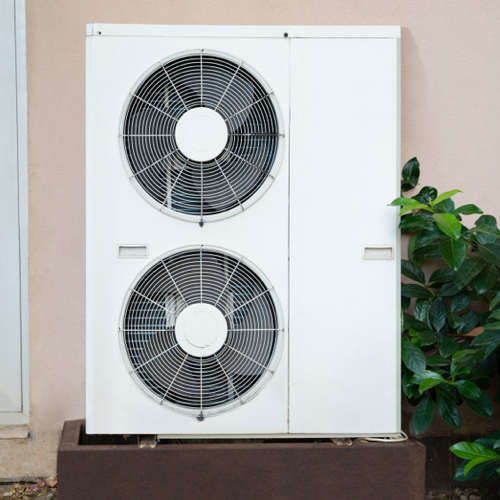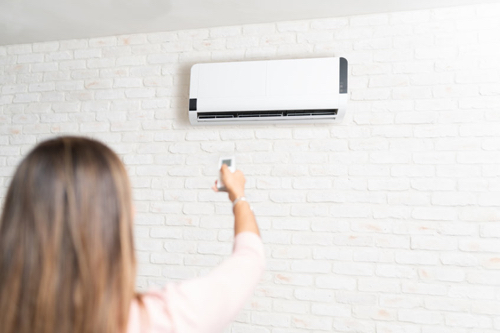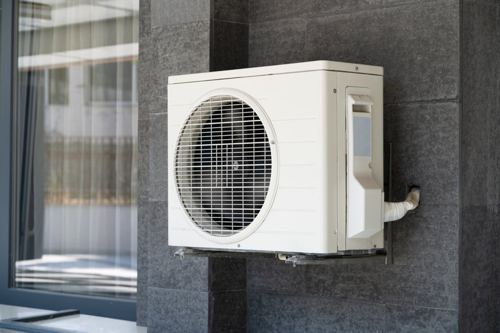
After Japan’s defeat in World War II, the American occupation of the country brought a lot of of America’s products to the country as it struggled to rebuild itself. One of those inventions the Japanese first imported was air conditioning to alleviate the sweltering Japanese summers.
Though the Japanese loved the technology, the format of large, noisy outdoor units and ductwork didn’t mesh well with small, thin walled Japanese homes that were placed on tight lots. So Japanese engineers got to work refining the technology to work with their method of construction and in 1959 Mitsubishi introduced the first mini-split air conditioner.
What is a Mini-Split?
A mini-split air is a compact, ductless air conditioner and heater. Mini-splits are extremely energy efficient compared to traditional air conditioners and are typically used to heat and cool individual rooms or areas.
Mini-splits have a small outside compressor unit connected to the indoor wall mounted evaporator. The design eliminates the need for duct work which saves on installation costs, complexity, and energy waste from leaky ducts.
The technology works much the same as a traditional heat pump air conditioner pulling heat out of the air via refrigerant lines using freon. In air conditioning mode it disperses the heat outside and releases the refrigerant cooled air inside from vents on the evaporator. In the heat mode the flow of the refrigerant is reversed and the heat blows inside and the cold is expelled outdoors.
Differences between AC and Mini-Split
With a traditional AC system you have a central thermostat that dictates the temperature of a whole house or a large portion of the home like the 2nd floor. One large outdoor compressor and indoor evaporator work together to generate cool air and disperse it throughout the home via a network of ducts.
This creates some very clear inefficiencies and generates a lot of wasted energy from the lack of local room by room control.
Issues with Traditional AC
- Inconsistent Temperatures – With a central thermostat it’s common that each room may be uncomfortably warm or cold compared to the temperature on the thermostat which can be far from the area in question. Maintaining a precise temperature in each bedroom from a thermostat located in a central hallway is not effective so this is one of the inherent limitations of a traditional AC system.
- Lack of Control – If you like a cold bedroom and your kids like a warmer bedroom somebody’s gonna have to compromise since there isn’t a way to have multiple temperatures set on a single system. Traditional ducted AC systems usually cover a multitude of rooms and so anything on that unit can only be set at that ”one size fits all” temperature.
- Inefficient Ductwork – Ducts are by design an inefficient piece of the AC puzzle. Blowing ice cold air 30-80 feet through a winding duct that is usually run through unconditioned areas of the home like a hot attic means that air is warming up during its travels losing much of its cooling power. Don’t forget about leaky ducts from critter damage, improper installation, or house movement that allow some of the air to escape before it gets to its destination room.
- Invasiveness – Outdoor units for traditional AC systems are quite large compared to mini-split systems. If you have an old house where installing new ductwork is required you will also create a lot of damage to plaster ceilings or have to deal with cutting through framing members to retrofit the ductwork. All this is avoided with a mini-split system where there is no ductwork.
Is a Mini-Split Right For You?
A mini-split works very well in a multitude of situations but it isn’t for everyone. They have been extremely popular in Asian and European markets, but slow to catch on in the US. But just because there aren’t mainstream here yet doesn’t mean it’s not a good option for you.
Appearance
The biggest issue most people have with mini-splits is the appearance. While it has a smaller outdoor unit the indoor unit is much more noticeable.
In a traditional AC system all you have are vents in your ceiling or walls, but with a mini-split you get a large 36” x 12” AC unit mounted to your wall. And that same wall unit needs to mounted in multiple locations around the house if you want the localized control these units are known for.

You can get multi-zone mini-splits where one outdoor unit runs up to 4 indoor units as long as you are ok with the appearance and have wall locations for the indoor units.
Massive Energy Efficiency
The energy efficiency of mini-splits is really unmatched. The energy use of HVAC systems is classified by a SEER (Seasonal Energy Efficiency Rating) number. The higher the number the more efficient the system. To learn more about SEER ratings check out the link above.
The lowest SEER rating you can get as of the writing of this post is 13 SEER, but you can go as high as 25 SEER. The difference in energy usage between those ranges is huge, but so is the price difference. Most new installations are in the 14-17 SEER range for traditional AC systems.
Ductless mini-split units usually start around 17 SEER and can run as high as the mid 30s! That kind of energy savings over a traditional AC is incredible! As someone who has installed a few ductless mini-splits I can tell you I didn’t even see my utility bill change after the additional unit was installed.

Cost
The cost of a mini-split system is actually quite affordable for the level of efficiency that you get. You can find a single-zone 19 SEER 1-room mini split for only $800. For a larger system like a 4-zone 22 SEER mini split you can grab one of those for between $3,000 and $4,000. Compare that to $5,000 to $7,000 for a 22 SEER traditional AC unit and you can see the significant savings.
Installation costs are significantly less for a mini split as well. According to Angi.com the average cost to install a mini-split is around $1,100 compared to $1,775 for a traditional AC system or $3,075 for a new installation requiring all new ductwork.
My Experience
As a contractor who has installed a couple mini-split units in my own house I can say that the flexibility is what I love best. For projects like my garage apartment or when I added a new attic bedroom the mini-split was the perfect solution since connecting these new rooms to our existing AC would have caused the system to be undersized.
Plus when you have a room that would need to operate as a different zone or is rarely used like a guest room, movie theatre,or man-cave/she-den then having it on its own mini split makes a lot of sense so you’re not conditioning space you aren’t using.
Maybe a traditional HVAC is the right choice for you, but I think everyone should at least consider a mini-split before you spend a big chunk of change on a new system for your house. What do you think?

Founder & Editor-in-Chief
I love old houses, working with my hands, and teaching others the excitment of doing it yourself! Everything is teachable if you only give it the chance.


Our house is an old 2-story craftsman brick home from 1928. There is currently no AC and I have been avoiding putting any holes in the brick. Is a mini-split a decent approach here?
What is the alternative to the wall mounted unit in an upstairs bedroom, with low ceilings and the only wall that is an outside wall has a large window that makes hanging a unit impossible? My bedroom in this Craftsman home has lots of nooks & crannies, closets, doors or windows on every wall. I could remove a dresser and put a floor unit, however, the wall backs up to the closet, not the outside.
Thank you for the great article on mini-split systems. Our old farmhouse doesn’t have ducts on the 2nd floor. We use convection heaters upstairs and window a/c’s for cooling on both floors. Some of the rooms aren’t used all the time and we keep the doors closed. We have been considering getting estimates for a mini-split system and this has been very helpful. We’ll be calling our local HVAC company very soon. Again, thank you for the information for an affordable alternative. Ductless in Iowa
Yes, the wall units are major eyesores especially in a period home. We are considering floor mounted mini-splits with custom “radiator covers” that will allow the mini-split to vent without obstructing the air. Have you had any experience with the floor mount minis?
Here you compared a mini split to a traditional duct system. How do they compare to a high velocity mini duct system like Unico? We have an old house with three floors that have enough cavity spaces to run mini ducts. What are the cost benefits between mini split and mini duct?
So Scott, how do these systems work in an older house with no duct work? Can you cool down rooms upstairs and downstairs afforably?